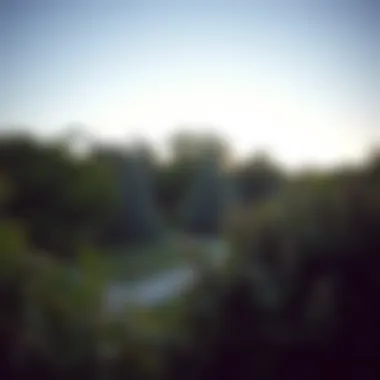Fast-Growing Privacy Trees for Alabama Landscapes


Intro
In the heart of Alabama, where the scent of magnolia and the vibrant rhythm of nature blend seamlessly, privacy trees serve as both silent guardians and aesthetic enhancers of our personal spaces. With rising population densities and the increasing desire for serene outdoor havens, understanding which trees can provide quick coverage while harmonizing with Alabama's unique climate is essential for homeowners and landscaping enthusiasts. This article dives deep into the characteristics and selection of fast-growing privacy trees that thrive in the southern soil, aiming to equip readers with the knowledge to craft lush, green screens that enhance their properties.
Privacy trees go beyond mere aesthetics; they offer protection from wind, noise, and nosy neighbors while increasing property value. Alabama's humid subtropical climate, with its hot summers and mild winters, plays a significant role in determining which species will flourish. Homeowners looking to balance privacy with beauty need a comprehensive understanding of species’ growth rates, adaptability, and maintenance needs.
So let’s delve into the lush world of fast-growing trees that promise not just expedited growth but also aesthetic charm, providing the perfect backdrop for gatherings, quiet mornings, or simply enjoying nature right in your backyard.
Overview of Privacy Trees
In the realm of landscaping, privacy trees play a pivotal role in not just enhancing the aesthetics of outdoor spaces, but also in providing the much-needed seclusion that many homeowners desire. The growing interest in creating private havens has sparked a keen focus on fast-growing privacy trees, particularly in regions like Alabama, where the climate and soil conditions can be quite conducive to their growth. This article sets out to navigate the essential aspects of selecting the right types of trees that can flourish rapidly, transforming yards into serene retreats.
Significance of Privacy Trees
Planting privacy trees can significantly influence the overall atmosphere of a home’s exterior environment. These trees act as natural barriers against noise, winds, and prying eyes, offering a sense of sanctum. For many, the sight of tall, lush greenery can evoke feelings of peace and relaxation. When it comes to Alabama, characterized by its humid subtropical climate, the choice of tree species becomes even more crucial. Certain varieties thrive better in this climate, growing fast while providing dense foliage for effective coverage. A well-planned line of privacy trees can enhance the value of a property, making it more attractive to potential buyers or visitors
Benefits of Fast-Growing Varieties
Fast-growing privacy trees provide instant gratification, a refreshing characteristic for impatient homeowners or those looking to create external spaces quickly.
- Immediate Privacy: Unlike slower-growing options, these trees can quickly obscure views from neighbors or street traffic, allowing homeowners to enjoy their outdoor areas in peace.
- Landscape Design Flexibility: Fast growth gives homeowners the ability to adapt landscape designs as per need without waiting years for trees to mature.
- Environmental Benefits: Fast-growing trees, such as Leyland Cypress or Green Giant Arborvitae, typically contribute to improved air quality, acting as natural air filters and reducing dust.
- Biodiversity Attraction: Many fast-growing privacy trees can also serve as habitats for birds and beneficial insects, enriching local biodiversity.
Given the right care, these trees can offer numerous benefits, blending beautiful landscapes with functional advantages. In a state where outdoor living is cherished, well-selected privacy trees can truly enhance the experience of Alabama's natural beauty.
Best Fast-Growing Privacy Trees for Alabama
When considering the ideal fast-growing privacy trees for Alabama, it’s crucial to focus not just on the speed of growth, but also on factors like climate resilience, maintenance requirements, and overall aesthetic value. Homeowners in Alabama are on the lookout for trees that can form a solid barrier against noise, wind, and prying eyes, enhancing both their property's privacy and its visual appeal. In this state, a variety of trees flourish, each offering unique benefits that cater to specific needs and preferences.
Choosing the right trees can lead to a garden that is not only practical but also visually striking. Fast-growing varieties are particularly valuable for those wanting immediate results, as they establish a privacy screen in a shorter duration compared to slower-growing alternatives. This section will delve into the specific trees suited for the Alabamian environment, highlighting their growth characteristics, aesthetic contributions, and the conditions they favor for optimal growth.
Leyland Cypress
Growth Rate and Characteristics
Leyland Cypress is a top contender when it comes to fast-growing privacy trees. This tree is known for its swift growth, often reaching heights of up to 70 feet within just a few years. The light green foliage forms a dense, bushy appearance that serves as an effective windbreak and visual barrier. A key characteristic of the Leyland Cypress is its rapid vertical growth, making it ideal for enclosing properties or creating an isolated backyard oasis. The downside, however, is its susceptibility to certain pests and diseases if not properly cared for, which we will address in maintenance sections.
Optimal Planting Conditions
For optimal growth, Leyland Cypress prefers well-drained soils with good moisture levels. It's adaptable and can withstand varying pH levels, which gives it an edge in Alabama’s diverse soil types. Planting them in a sunny spot will yield the best results, allowing these trees to harness sunlight and promote robust growth. However, it's important to note that while they thrive in many conditions, excessively wet soils can lead to root rot, so good drainage is key to their survival.
Eastern Red Cedar
Environmental Adaptability
The Eastern Red Cedar distinguishes itself with remarkable adaptability. It can survive in poor soil conditions and withstand drought, which is advantageous in Alabama's sometimes erratic climate. This adaptability makes it a fine addition for those looking to enhance their yard while minimizing upkeep. Additionally, the tree’s resistance to pests and diseases adds to its allure, ensuring that it requires less intervention than other varieties. However, its adaptability doesn't mean it's invincible. Extreme flooding or prolonged drought can still stress the tree and affect its health.


Maintenance Requirements
The maintenance needs of Eastern Red Cedar are minimal compared to other species. They don’t require frequent pruning, and their resilience means that they can thrive without much care once established. Still, it's wise to keep an eye on their growth, as over time, they can spread if not monitored. A well-pruned cedar can maintain a healthy shape and size, making it not just a practical choice, but a visually appealing one.
Green Giant Arborvitae
Resistance to Pests
This variety is particularly favored for its resistance to pests, which is a significant benefit for Alabama gardeners who want to avoid continual pest management. The Green Giant Arborvitae is sturdy against common threats like spider mites and aphids. Its natural resilience means less hassle for homeowners concerned about maintaining the health of their tree line. Additionally, its fast growth rate enriches landscapes quickly, and its lush green foliage pairs beautifully with various plantings, adding a pop of life to any garden.
Visual Appeal
Green Giant Arborvitae also brings undeniable visual appeal. Its conical shape is pleasing to the eye, and when planted in rows, they can act as a beautiful living wall. This greenery not only enhances privacy but serves as an ornamental feature, accentuating the overall landscape of a property. Though generally low-maintenance, it’s worth noting that they do prefer full sun, meaning adequate sunlight is crucial for vibrant growth and form.
Bamboo Varieties
Quick Growth and Height
If you’re in the market for rapid growth and considerable height, bamboo varieties are intriguing. Certain species like the Moso bamboo can reach up to 35 feet in a single growing season! This robust growth makes bamboo ideal for establishing privacy screens in mere months. However, one must be cautious, as some bamboo can be invasive if they are not properly contained. When appropriately managed, they can create a serene and green privacy wall.
Controllable Spreading
A noteworthy feature of bamboo is that its spreading can be controlled through regular maintenance and planting methods. Using clumping varieties rather than running types can reduce the risk of bamboo taking over your yard. Setting up barriers or planters can also help muse its spreading, allowing homeowners to enjoy bamboo’s fast growth without the invasive drawbacks.
In summary, selecting the right fast-growing privacy trees for Alabama can significantly enhance not just privacy but also the overall beauty of outdoor spaces. Each species discussed offers its unique characteristics, and understanding these can help homeowners make informed choices that align with their specific landscaping goals.
Factors Influencing Growth Rates
Understanding the factors that influence the growth rates of privacy trees is essential for anyone looking to enhance their outdoor space. This section provides insights on the specific elements that affect how well these trees will thrive in Alabama's climate. By grasping these concepts, homeowners, gardening enthusiasts, and landscape professionals can make decisions that will lead to robust, healthy trees. A successful planting strategy doesn’t just hinge on the selection of the species; it also depends on recognizing how environmental conditions can greatly impact growth.
Soil Conditions in Alabama
The soil in Alabama varies significantly across different regions, impacting how effectively trees can grow. Generally speaking, most of Alabama boasts a sandy or clay-rich soil type. These conditions can align perfectly with the growth needs of certain tree species while posing challenges to others. Here are a few considerations:
- pH Levels: The acidity or alkalinity of the soil can significantly influence nutrient availability. Most fast-growing privacy trees prefer slightly acidic to neutral soil (pH 6.0 to 7.0).
- Nutrient Content: Some species thrive in nutrient-rich soils, while others are more tolerant of poorer conditions. Conducting a soil test can help identify what your soil might lack.
- Drainage: Proper drainage is often overlooked. If water sits in the soil for too long after rain, root rot can set in, stifling growth.
Key Tip: Amending soil with organic matter like compost can improve both nutrient content and drainage, setting a solid foundation for your privacy trees.
Moisture and Watering Needs
Moisture is another crucial aspect that influences the growth rate of privacy trees. In Alabama, rainfall can be unpredictable, swinging from heavy downpours to dry spells. Here's how to navigate these variations:
- Initial Watering: Newly planted trees need consistent moisture to establish roots. Regular watering for the first few months is crucial.
- Established Trees: As the trees mature, they may require less frequent watering. However, during extremely hot summers, supplemental watering might be necessary.
- Irrigation Systems: Installing a drip irrigation system can help maintain moisture consistency without over-saturating the soil.
"Watering is as vital as sending the kids to school—miss it, and it shows."


Sunlight Requirements
Sunlight plays a pivotal role in the growth of any plant, including privacy trees. Alabama is known for its sunny climate, yet certain tree species have preferences regarding light exposure:
- Full Sun: Some trees like the Green Giant Arborvitae thrive in full sun, needing at least six hours of direct sunlight per day.
- Partial Shade: Other species, such as the Eastern Red Cedar, can tolerate some shade but need adequate light for optimum growth.
- Placement: Pay attention to how existing structures and trees might cast shade. Strategic placement can make all the difference in how quickly your trees grow.
In summary, understanding these factors—soil conditions, moisture, and sunlight requirements—sets the stage for successfully cultivating fast-growing privacy trees. Those who take the time to prepare and adapt their planting strategies are more likely to enjoy the lush, green privacy they desire in their outdoor spaces.
Caring for Privacy Trees
Caring for privacy trees plays a pivotal role in maintaining the integrity and visual appeal of your landscape. In Alabama's unique climate, characterized by varying temperature extremes and rainfall patterns, how you nurture these trees can significantly influence their longevity and growth. With the right practices, you can ensure these trees thrive, providing that much-needed privacy and aesthetic value to your outdoor spaces. Whether you're an avid gardener or a homeowner looking to create an inviting environment, understanding the nuances of tree care is vital.
Pruning Techniques
Pruning isn’t merely about cutting branches; it’s a strategic approach to shaping your trees, promoting healthy growth patterns, and enhancing their resistance to pests. In Alabama, pruning should generally occur during the dormant season, typically late winter or early spring. This timing helps minimize stress on the tree while promoting vigorous growth come springtime.
- Assess the Tree Structure: Before you trim, step back and look at the tree’s shape. Focus on removing dead or damaged branches first. This helps open up the crown, allowing light to reach inner foliage.
- Use Sharp Tools: Always employ sharp, sanitized pruning shears or saws. Clean cuts heal quicker, reducing the chance of disease.
- Shaping for Screening: When aiming for privacy, consider the height and spread of your trees. Regularly trimming the top encourages upward growth, while side pruning can help thicken the sides, leading to a lush and dense cover.
Remember, moderation is key. Over-pruning can stoke stress and slow growth.
Fertilization Tips
Fertilization has a crucial impact on the health and vitality of your privacy trees. Alabama’s soil can vary significantly, with certain areas being sandy while others may be clay-heavy. Conducting a soil test can pinpoint nutrient deficiencies specific to your area, guiding your fertilization strategy. Here’s how to proceed:
- Choose the Right Fertilizer: Opt for slow-release fertilizers tailored for trees. Look for a balanced formula like 10-10-10 or one rich in nitrogen which promotes growth.
- Timing Matters: Fertilize in early spring before the trees start to bloom. This gives the roots ample time to absorb nutrients before the growing season kicks in.
- Application Method: Spread the fertilizer evenly around the base of the tree, extending to the drip line where the leaves end. This ensures the roots can efficiently absorb the nutrients.
Regular fertilization can enhance growth rates and improve the overall health of your privacy trees, turning a simple green wall into an impressive barrier!
Pest Management Strategies
Keeping your privacy trees flourishing goes hand-in-hand with effective pest management. Alabama’s warm climate can be attractive to a slew of tree pests. Integrated Pest Management (IPM) offers a holistic approach to pest control, promoting a healthy ecosystem:
- Regular Inspections: Make it a habit to regularly inspect your trees. Early detection of pests can save your trees from extensive damage. Look for signs of discolored leaves, unusual webs, or holes in foliage.
- Natural Predators: Encourage beneficial insects like ladybugs and lacewings which feed on common pests. Planting herbs such as basil or dill nearby can attract these natural predators.
- Organic Treatments: If infestations occur, consider organic pesticides. Neem oil and insecticidal soap are effective and less harmful to beneficial insects compared to chemical options.
By adhering to these practices, you can ensure a vibrant, healthy privacy screen that enhances your outdoor living space.
Designing Your Outdoor Space with Privacy Trees
When considering how to enhance your outdoor space, the strategic implementation of privacy trees can’t be overlooked. These trees serve not just for aesthetics but also play a vital role in creating refuge-like atmospheres for homeowners. Incorporating fast-growing privacy trees into your landscape design can lead to numerous benefits, ranging from improved privacy to habitat creation for local wildlife. Therefore, understanding how to effectively design with these trees will ultimately maximize their impact on your property.
Arranging Trees for Maximum Effect
An important aspect to keep in mind is the arrangement of your privacy trees. The placement of trees can significantly influence how well they perform their function of providing privacy. Start by visualizing your space. Here are some tips:
- Layer your Trees: Use a combination of different heights and types of trees. Taller species in the back provide a backdrop, while shorter varieties in front can create a fuller appearance.
- Continuous Coverage: Spacing is also key. Aim for a distance that allows for full growth without gaps in coverage. Depending on variety, trees should be spaced at least six feet apart but closer for dense hedging.
- Grouping: Arranging trees in clusters can create a more natural look. It prevents them from appearing as a long, uninviting wall and can encourage healthy growth due to shared moisture and nutrients.


By arranging trees correctly, you can maximize visual interest and functionality, creating a seamless blend of privacy with natural beauty.
Complementing Existing Landscaping
Integrating privacy trees with your existing landscape features can elevate your outdoor space to new heights. Look for ways these trees can harmonize with other elements:
- Color Coordination: Choose tree species that complement the color palette of your garden or house. Trees with vibrant foliage can serve as seasonal interest points.
- Mixing Textures: Different tree leaves and bark types add depth. A privacy screen of glossy-leaved Leyland cypress can contrast beautifully with the soft needles of Eastern Red Cedar.
- Functional Spaces: Think about how trees can define areas in your yard. They can create boundaries for seating areas or children’s play zones, making your landscape more segmented and inviting.
This thoughtful integration not only secures your privacy but also adds an aesthetic charm that can make outdoor gatherings more enjoyable.
Creating Natural Screens
Using fast-growing privacy trees to create natural screens goes beyond just blocking views. They can also reduce noise pollution and act as windbreaks, enhancing comfort in your outdoor environment.
- Choose the Right Species: Depending on what you're screening (neighbors, noise, wind), select trees that are tall and dense enough to serve the purpose. Green Giant Arborvitae, for instance, offers excellent density.
- Layered Structure: Implement layers of underbrush or lower-growing shrubs alongside taller trees. This introduces a variety of heights and adds to the overall screening effect. It’s amazing to see how effective a mixed hedge can be in creating an effective barrier while also pleasing to the eye.
- Maintaining Growth: Regular maintenance of these screens is essential. Trimming and shaping promote denser growth and ensure that your natural screen continues to perform over the years.
Effective design doesn’t just happen; it’s a careful process. Creating privacy through nature demands anticipation and planning.
In summary, designing your outdoor space with privacy trees is about more than just planting a few trees and waiting. It requires attention to detail in arrangement, compatibility with existing landscaping, and implementation for effective natural screening. By mastering these components, homeowners can create stunning privacy solutions that marry functionality with aesthetic beauty.
Challenges and Considerations
When embarking on the journey of planting fast-growing privacy trees in Alabama, it’s essential to acknowledge the challenges and considerations that may arise. Selecting the right tree goes beyond just a desire for a green wall; it involves understanding the environment, potential threats, and the nature of the plants themselves. This aspect of your gardening journey is vital, as it lays the groundwork for a thriving growth experience, ensuring that your privacy trees not only survive but flourish in your particular setting.
Weather-Related Challenges
Alabama’s weather is as diverse as its landscape, presenting unique conditions that can impact the growth and health of your chosen trees. From brutal summer heat to unpredictable winter storms, the elements can be your greatest ally or a formidable adversary.
- Heat Stress: During the scorching summer months, trees can struggle if they’re not suited to the high temperatures and humidity. Some species may become stressed and show slowed growth or even start to droop under the heat.
- Winter Impacts: While Alabama doesn’t experience extreme winters, occasional cold snaps can still harm trees not acclimated to lower temperatures. This risk necessitates selecting varieties that can withstand surprising drops in temperature.
- Precipitation Patterns: Alabama's rainfall can be sporadic, swinging from heavy downpours to dry spells. It’s crucial to understand the watering needs of your trees to prevent over- or under-watering.
It’s also beneficial to explore local weather patterns and historical data for your specific area. Knowing whether you are in a region that usually experiences more rainfall or prolonged droughts can aid in selecting the most suitable species for your yard.
Invasive Species Awareness
As the saying goes, "All that glitters is not gold," and this holds particularly true when it comes to certain fast-growing privacy tree species that may find their way into the Alabama soil. You might stumble upon trees that are breathtaking in growth but can turn into invasive species, wreaking havoc on local ecosystems.
- Understanding Invasiveness: Before planting, it’s vital to do your research. Species that grow like wildfire often spread uncontrollably, crowding out native flora and destabilizing local habitats. For instance, the infamous Chinese Tallow Tree appears attractive for quick coverage but poses a significant risk by forming dense stands that displace beneficial species.
- Responsible Sourcing: When selecting trees from nurseries or garden centers, ensure that the suppliers adhere to responsible practices. Many states, including Alabama, have lists of invasive species. Consult local resources, perhaps through your local extension service or environmental organizations, to avoid such pitfalls.
Taking the time to understand weather-related challenges and being aware of invasive species not only benefits your immediate landscape but also ensures the longevity and health of Alabama’s diverse ecosystems. By making mindful choices, you can cultivate a lush space that serves its purpose while contributing positively to the local environment.
Ending
As we wrap up our exploration, it’s crucial to reflect on the essence of selecting fast-growing privacy trees. These trees become more than mere blocks; they symbolize security and comfort, creating a sanctuary within the unpredictable dance of Alabama's environment. Choosing the right species not only enhances your property’s aesthetic appeal but also serves to significantly improve your outdoor living space.
Choosing trees like Leyland Cypress or Green Giant Arborvitae is not just about speed; it’s about understanding the landscape's nuances. Fast-growing varieties offer immediate benefits, yet they come with considerations that need acknowledgment. Proper maintenance, such as adequate pruning and understanding their water and light needs, can make all the difference.
Moreover, the role of trees in combatting the harsh sunlight and providing cooling shade cannot be overstated. It aligns seamlessly with both ecological sustainability and the desire for privacy.
"The right tree at the right time can transform a yard from a mere space into a thriving habitat for both humans and wildlife."
However, do bear in mind the balance required when choosing these plants. Understanding how they interact with the local ecosystem, including awareness of invasive species, is key. Consider the environmental footprints of these species and their long-term impacts on your property and community.







